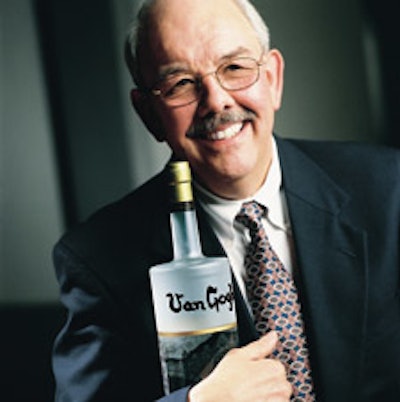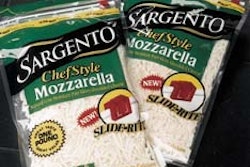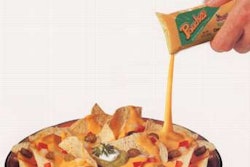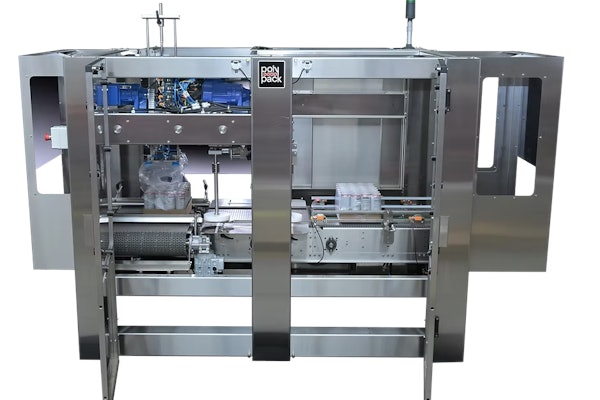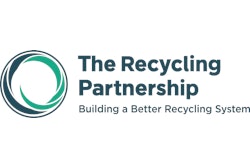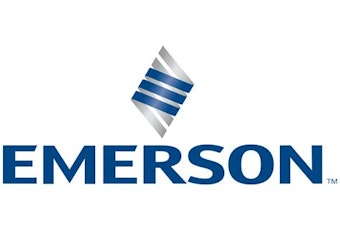David Van de Velde’s Dutch heritage continues to be used to great advantage in the spirits business. He claims to be responsible for bringing Ketel One vodka from Holland and making it successful in the United States. After trying to “retire,” Van de Velde is at it again as president of Luctor Intl., Reno, NV, the company responsible for a new line of spirits aimed specifically at the U.S. market.
But if Van de Velde is Dutch-centric, he’s also very packaging-centered. In fact, it took Luctor more than two years to secure the rights to the Vincent Van Gogh name and artwork that decorate Luctor’s bottles, and to oversee development of the processes used for decorating and corking these containers.
“You have to come out with a ‘wow’ concept,” he bubbles. “First off, you have to have a ‘wow’ name. Second, we had to come up with a ‘wow’ package design. Finally, you have to have a ‘wow’ product in the package.” Eventually, Van de Velde worked with CLM Design (Reno, NV) to create the graphics for the various bottles. Those graphics were executed in Europe, all under the guidance of Thijssens Packaging (Amsterdam, the Netherlands), Luctor’s packaging consultant. Identification of individual suppliers was not provided; the company prefers to keep them confidential.
“The graphic design was the concept of our president,” says Roseanne Hardenbrook, vice president of marketing at Luctor. “The design was his idea. The first product was our Van Gogh Gin, which came out in the fall of ’99. In the foreground is one of Amsterdam’s most famous bridges over a canal. Through the front window of the etched bottle, you see all the houses and buildings around the canal in a panoramic view.”
That same “window” concept is also used for this year’s line of Vincent vodkas: a regular vodka and two flavored versions, Oranje (orange) and Citroen (a lemon flavor, not the French automobile). In a slight variation, Luctor recently introduced Starry Nights, an orange-flavored liqueur whose blue product color helps form the basis for the reproduction of the painting on the bottle.
Securing the rights
Returning to Van de Velde’s concept, his first question was: How do you penetrate the consumers’ minds with a recognizable name that stands for Dutch top quality, expensive, a true classic? “Everybody knows Van Gogh,” he points out.
However, adds Hardenbrook, it took two trademark attorneys to secure the rights for Luctor to use the name and the reproductions of the paintings. “It was a major battle to secure the rights for the name and the artwork for spirits products,” says Van de Velde.
The story of the package is a compelling one. “We had so many obstacles to overcome to create this package,” recalls Van de Velde. “For example, how can you screen print 16 colors on the bottle when it takes time to dry the paints each time? So we had to come up with special pigments that would dry more quickly, but with tight tolerances so the pictures would be perfect renditions of Van Gogh’s work. The tolerance is less than one-half millimeter,” he says.
The custom bottle itself was a challenge. It’s made in Germany, says Hardenbrook, because it’s the only European country that doesn’t mix colors when glass is recycled. And clarity is critical for a design that uses the crystal clarity of the bottle and product to show through the graphics printed on the circumference.
Then there was the issue of the square shoulder. “Typically, a square-shaped shoulder makes a glass bottle weak there. So our bottlemaker had to come up with a process design so the shoulder would be strong enough to accommodate stacking in cases. This was a technical achievement,” Van de Velde says.
Etching & decorating
Once the bottle is produced in Germany, it travels to France for acid-etching, a process that virtually all premium vodkas seem to employ.
While etching has become a standard, Luctor’s products are among relatively few that require a crystal-clear window. Thus, says Hardenbrook, the French company developed a system for applying a plastic base film to the window area that protects the flint glass from the acid bath, yet burns off later in an oven to reveal the clear glass window.
Next, the etched bottle travels to Belgium, where artisans apply the 16 colors via screen printing. At the same company, an 18-carat gold band is also applied around the bottle. Once decorating is complete, the bottle is shipped to Dirkzwager Distillery (Schiedam, the Netherlands), which produces the product and fills the bottles under exclusive contract.
The final country involved is Portugal, where a special cork and process had to be created. A little piece of cork in a bottle of wine isn’t terribly unusual, Van de Velde says, but he realizes it’s unlikely anyone would buy a clear spirit with little pieces of cork floating in it. “It would appear the product was dirty or filtration didn’t work properly.” The American consumer wants a cork in a premium product like this, he adds, but the alcohol attacks the cork. So a special patent-pending process to treat the cork had to be developed, so pieces will not break off.
Costly, but necessary
Van de Velde is understandably proud of the product’s five-star rating, and its 94 score from Wine Enthusiast. So that completes his “wow” trifecta. “We’re selling not just a spirit, we’re also selling image. Today, Americans use packaging as extensions of an individual’s identity. In the liquor business, it’s packaging, packaging, packaging.”
His goal, he says without caution, was to create the ultimate spirits products in the ultimate package. “I knew it was going to cost a lot of money, but I feel it’s the ultimate for today. That’s why I felt the Vincent Van Gogh name, the pictures on the package, the product inside, everything had to be perfect,” says Van de Velde. “I think we did that.”
